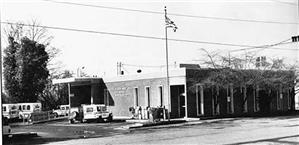The opening of a post office is an important marker of the beginning of a community. On August 6, 1889, Des Moines Post Office opens. James F. Hiatt is the first postmaster. Des Moines is located on the shores of Puget Sound, 12 miles north of Tacoma and 14 miles south of Seattle.
The post office was located in Hiatt's general store near the waterfront at the corner of Cliff Avenue and Cherry Street (which was located between the future S 220 and 223rd streets).
Des Moines started as a real estate development. In 1888, F. A. Blasher arrived in King County from Des Moines, Iowa, and began investing in land. In early 1889, he purchased a 154 acre homestead in southwest King County. Blasher and three other investors formed the Des Moines City Improvement Company to develop the property. On July 29, 1889, they filed the Town of Des Moines 120-acre subdivision. Within a week of that, the post office was established. Within a few months the first postmaster James Hiatt sold his grocery store to James K. Ely, and on February 8, 1890, the Post Office Department appointed Ely postmaster.
An 1890 description of Des Moines intended for promotional purposes exaggerated the number of buildings and perhaps some other things as well:
"Des Moines now has about 300 houses, including residences, business blocks, a school, churches, mercantile houses representing every branch of trade, hotels, blacksmith and wagon shops, a sawmill employing 25 hands, a chair factory, boat manufactory, brickyards, and the only tin factory on the coast. The company has communications from capitalists asking for sites for the establishment for various manufacturing enterprises, which will in the near future afford employment to a large number of skilled mechanics..." (Kennedy, p. 16).
The 1890 census found that Des Moines had a population of 212 persons, which makes 300 buildings sound improbable.
By 1892, with Des Moines at the peak of its business activity for the early period, the following establishments conducted business:
- J. G. Ely grocery
- Young Brothers General Store
- William H. Martin boat builder
- E. J. Martin hotel
- The Finnell Brothers and Joseph Sparling sold real estate
- S. B. Vrooman notarized real estate deeds
- William Vann Gaskin operated a sawmill at the mouth of Des Moines Creek that employed about 15 men
- James Markwell ran a roof shingle bold mill that employed 25 men
- North of town, Mr. Cooper operated a black gunpowder manufacturing plant established in 1889
Before the end of 1890, the post office moved across the street to the home of the new postmaster, William H. Bailey. Apparently Bailey was blind, and had an assistant sort the mail for him. On March 7, 1892, Miss Nettie Finnell became the new postmaster. She moved the post office to her house on Grand Avenue (future 6th Avenue S, just north of S 225th Street). She continued in this position through two marriages until 1910.
Initially, the post office delivered mail to Des Moines via steamer from Tacoma. By 1893 or 1894, the mail arrived overland from Tacoma. Two or three times a week, a rider on horseback crossed the Tacoma tideflats and followed the old military road to drop the mailbag off at Des Moines. He continued on his route to Buenna, Adelaide, and Steele's Landing before returning to Tacoma. By the late 1890s, the postal department had reestablished steamship delivery along the Tacoma-Seattle route.
In 1893, when a depression hit the nation, the booming town imploded. Businesses moved or went bankrupt. The Markell mill and the Young Brothers store were probably the only businesses to survive into the twentieth century. In 1900, despite the 1897 gold rush that lifted Seattle out of the doldrums, Des Moines had lost more than 20 percent of its 1890 population. The developer's plans for a large residential area lay fallow for decades.

